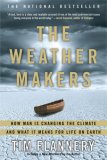Summary | Excerpt | Reviews | Beyond the Book | Readalikes | Genres & Themes | Author Bio
How Man Is Changing the Climate and What It Means for Life on Earth
by Tim Flannery

Critics' Opinion:
Readers' Opinion:
First Published:
Mar 2006, 352 pages
Paperback:
Jan 2001, 400 pages
 Book Reviewed by:
Book Reviewed by:
BookBrowse Review Team
Buy This Book
THE SLOW AWAKENING
In 1981, when I was in my midtwenties, I climbed Mt. Albert Edward, one of the highest peaks on the verdant island of New Guinea. Although only seventy-four miles from Papua New Guinea’s national capital, Port Moresby, the region around Mt. Albert Edward is so rugged that the last significant biological work conducted there was by an expedition from the American Museum of Natural History in the early 1930s.
The bronzed grasslands were a stark contrast to the green jungle all around, and among the tussocks grew groves of tree ferns, whose lacy fronds waved above my head. Wallaby tracks threaded from the forest edge to the herbfields that flourished in damp hollows, and the scratchings and burrows of yardlong rats and the traces where long-beaked echidnas had probed for worms were everywhere. Many of these creatures, I later discovered, were unique to such alpine regions.
Downslope, the tussock grassland ended abruptly at a stunted, mossy forest. A single step could carry you from sunshine into the dank gloom, where the pencil-thin saplings on the margin were so festooned with moss, lichens, and filmy ferns that they ballooned to the diameter of my waist. In the leaf litter on the forest floor, I was surprised to find the trunks of dead tree ferns. Tree ferns grew only in the grassland, so here was clear evidence that the forest was colonizing the slope from below. Judging from the distribution of the tree fern trunks, it had swallowed at least thirty yards of grassland in less time than it takes for a tree fern to rot on the damp forest floor—a decade or two at most.
Why was the forest expanding? As I pondered the moldering trunks I remembered reading that New Guinea’s glaciers were melting. Had the temperature on Mt. Albert Edward warmed enough to permit trees to grow where previously only grasses could take root? And, if so, was this evidence of climate change? My doctoral studies were in paleontology, so I knew how important changes in climate have been in determining the fate of species. But this was the first evidence I’d seen that it might affect Earth during my lifetime. The experience left me troubled; I knew there was something wrong but not quite what it was.
Despite the good position I was in to understand the significance of these observations, I soon forgot about them. This was partly because, as I studied the various ancient ecosystems that our generation has inherited, seemingly bigger and more urgent issues demanded my attention. And some of the crises did seem dire: The rain forests that I was studying were being felled for timber and to make agricultural land, and the larger animal species living there were being hunted to extinction. In my own country of Australia, rising salt was threatening to destroy the most fertile soils, while overgrazing, degradation of waterways, and the logging of forests all threatened precious ecosystems and biodiversity. To me these were the truly pressing issues.
Whether we are crossing the road or paying the bills, it is the big, fast-moving things that command our attention. But seemingly large issues sometimes turn out to be a sideshow. The Y2K bug is one such example. Around the globe many governments and companies spent billions to prepare themselves against the threat, while others spent nothing; and 1999 gave way to 2000 with barely a hiccup, let alone an apocalypse. A skeptical eye is our greatest asset in dealing with this type of “problem.” And deep skepticism has a particularly important role to play in science, for a theory is only valid for as long as it has not been disproved. Scientists are in fact trained skeptics, and this eternal questioning of their own and others’ work may give the impression that you can always find an expert who will champion any conceivable view.
While such skepticism is the lifeblood of science, it can have drawbacks when society is called on to combat real dangers. For decades both the tobacco and asbestos industries found scientists prepared publicly to be doubtful about discoveries linking their products with cancer. A nonspecialist cannot know whether the view being presented is fringe or mainstream thinking, and so we may come to believe that there is a real division in the scientific community on these matters. In the case of asbestos and tobacco, the situation was made worse because cancers often appear years after exposure to carcinogenic products, and no one can say for certain just who, among the many exposed, will be struck down. By creating doubt about the link between their products and cancer, the tobacco and asbestos companies enjoyed decades of fat profits, while millions of people met terrible deaths.
Copyright © 2005 by Tim Flannery. Reprinted with permission from Grove Atlantic, Inc. All rights reserved.





The Funeral Cryer by Wenyan Lu
Debut novelist Wenyan Lu brings us this witty yet profound story about one woman's midlife reawakening in contemporary rural China.
Your guide toexceptional books
BookBrowse seeks out and recommends the best in contemporary fiction and nonfiction—books that not only engage and entertain but also deepen our understanding of ourselves and the world around us.